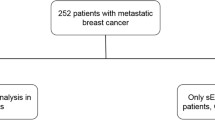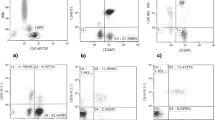Abstract
Objective
The aim of this study is to investigate clinical implications of human leukocyte antigen-G (HLA-G) expression in breast cancer.
Methods
HLA-G expression in 235 primary breast cancer tissues was investigated using immunohistochemistry, and plasma soluble HLA-G (sHLA-G) was measured in 44 breast cancer patients using a specific HLA-G enzyme-linked immunosorbent assay (ELISA). Effects of estradiol/progesterone and their antagonists tamoxifen/RU486 on HLA-G expression in cultured breast cancer MCF-7 cells were determined by real-time polymerase chain reaction (PCR) and the ELISA. Alterations of HLA-G expression by the hormone treatments on subsequent allocytotoxic lymphocyte (allo-CTL) response were also examined.
Results
In the study, approximately 66% of neoplasm lesions were identified to have positive HLA-G expression. This expression was significantly correlated with tumor size, nodal status, and clinical disease stage (P = 0.0001, 0.012, and 0.0001, respectively). Patients with positive HLA-G expression had a lower survival rate than those with negative expression (P < 0.028). Plasma sHLA-G levels were significantly higher in breast cancer patients than in healthy controls (P < 0.001), with the area under the receiver-operating characteristic (ROC) curve being 0.95. HLA-G expression in breast cancer MCF-7 cells was enhanced by estradiol/progesterone but reduced by their antagonists. Cytotoxicity studies showed that allo-CTL response in MCF-7 cells was inhibited by prior treatment with estradiol/progesterone, but was amplified by their antagonists. The effects could be restored or further strengthened by the addition of anti-HLA-G antibodies.
Conclusion
Our findings suggest that HLA-G may have potential clinical implications in diagnosis, prognosis, and immunotherapy of patients with breast cancer.





Similar content being viewed by others
References
LeMaoult J, Rouas-Freiss N, Carosella ED. Immuno-tolerogenic functions of HLA-G: relevance in transplantation and oncology. Autoimmun Rev. 2005;4:503–9.
Carosella ED, Moreau P, Lemaoult J, Rouas-Freiss N. HLA-G: from biology to clinical benefits. Trends Immunol. 2008;29:125–32.
Ye SR, Yang H, Li K, Dong DD, Lin XM, Yie SM. Human leukocyte antigen G expression: as a significant prognostic indicator for patients with colorectal cancer. Mod Pathol. 2007;20:375–83.
Yie SM, Yang H, Ye SR, Li K, Dong DD, Lin XM. Expression of HLA-G is associated with prognosis in esophageal squamous cell carcinoma. Am J Clin Pathol. 2007;128:1002–9.
Yie SM, Yang H, Ye SR, Li K, Dong DD, Lin XM. Expression of human leucocyte antigen G (HLA-G) is associated with prognosis in non-small cell lung cancer. Lung Cancer. 2007;58:267–74.
Yie SM, Yang H, Ye SR, Li K, Dong DD, Lin XM. Expression of human leukocyte antigen G (HLA-G) correlates with poor prognosis in gastric carcinoma. Ann Surg Oncol. 2007;14:2721–9.
Nückel H, Rebmann V, Dürig J, Dührsen U, Grosse-Wilde H. HLA-G expression is associated with an unfavorable outcome and immunodeficiency in chronic lymphocytic leukemia. Blood. 2005;105:1694–8.
Lefebvre S, Antoine M, Uzan S, McMaster M, Dausset J, Carosella ED, et al. Specific activation of the non-classical class I histocompatibility HLA-G antigen and expression of the ILT2 inhibitory receptor in human breast cancer. J Pathol. 2002;196:266–74.
Singer G, Rebmann V, Chen YC, Liu HT, Ali SZ, Reinsberg J, et al. HLA-G is a potential tumor marker in malignant ascites. Clin Cancer Res. 2003;9:4460–4.
Kleinberg L, Flørenes VA, Skrede M, Dong HP, Nielsen SR, McMaster MT, et al. Expression of HLA-G in malignant mesothelioma and clinically aggressive breast carcinoma. Virchows Arch. 2006;449:31–9.
Shih IeM. Application of human leukocyte antigen-G expression in the diagnosis of human cancer. Hum Immunol. 2007;68:272–6.
Benson JR, Pitsinis V. Update on clinical role of tamoxifen. Curr Opin Obstet Gynecol. 2003;15:13–23.
Klijn JG, Setyono-Han B, Foekens JA. Progesterone antagonists and progesterone receptor modulators in the treatment of breast cancer. Steroids. 2000;65:825–30.
Thomas M, Monet JD. Combined effects of RU486 and tamoxifen on the growth and cell cycle phases of the MCF-7 cell line. J Clin Endocrinol Metab. 1992;75:865–70.
Gaddy VT, Barrett JT, Delk JN, Kallab AM, Porter AG, Schoenlein PV. Mifepristone induces growth arrest, caspase activation, and apoptosis of estrogen receptor-expressing, antiestrogen-resistant breast cancer cells. Clin Cancer Res. 2004;10:5215–25.
Yie SM, Li LH, Li GM, Xiao R, Librach CL. Progesterone enhances HLA-G gene expression in JEG-3 choriocarcinoma cells and human cytotrophoblasts in vitro. Hum Reprod. 2006;21:46–51.
Sheshgiri R, Rao V, Tumiati LC, Xiao R, Prodger JL, Badiwala M, et al. Progesterone induces human leukocyte antigen-g expression in vascular endothelial and smooth muscle cells. Circulation. 2008;118(14 Suppl):S58–64.
Pangault C, Amiot L, Caulet-Maugendre S, Brasseur F, Burtin F, Guilloux V, et al. HLA-G protein expression is not induced during malignant transformation. Tissue Antigens. 1999;53:335–46.
Fleming I, Cooper J, Henson D, Hutter R, Kennedy B, Murphy G, et al. (editors) American Joint Committee on cancer staging manual. 5th ed. Philadephia: JB Lippincott;1997.
Yie S, Li L, Li Y, Librach C. HLA-G protein concentrations in maternal serum and placental tissue are decreased in preeclampsia. Am J Obstet Gynecol. 2004;191:525–9.
Kapasi K, Albert SE, Yie SM, Zavazava N, Librach CL. HLA-G has a concentration-dependent effect on the generation of an allo-CTL response. Immunology. 2000;101:191–200.
Alexander J, Watanabe T, Wu TT, Rashid A, Li S, Hamilton SR. Histopathological identification of colon cancer with microsatellite instability. Am J Pathol. 2001;158:527–35.
Livak KJ, Schmittgen TD. Analysis of relative gene expression data using real-time quantitative PCR and the 2–ΔΔCt method. Methods. 2001;25,402–8.
Ugurel S, Rebmann V, Ferrone S, Tilgen W, Grosse-Wilde H, Reinhold U. Soluble human leukocyte antigen–G serum level is elevated in melanoma patients and is further increased by interferon-alpha immunotherapy. Cancer. 2001;92:369–76.
Leleu X, Le Friec G, Facon T, Amiot L, Fauchet R, Hannache B, et al. Total soluble HLA class I and soluble HLA-G in multiple myeloma and monoclonal gammopathy of undetermined significance. Clin Cancer Res. 2005;11:7297–303.
Gros F, Sebti Y, de Guibert S, Branger B, Bernard M, Fauchet R, et al. Soluble HLA-G molecules increase during acute leukemia, especially in subtypes affecting monocytic and lymphoid lineages. Neoplasia. 2006;8:223–30.
Sebti Y, Le Maux A, Gros F, De Guibert S, Pangault C, Rouas-Freiss N, et al. Expression of functional soluble human leucocyte antigen-G molecules in lymphoproliferative disorders. Br J Haematol. 2007;138: 202–12.
Morandi F, Levreri I, Bocca P, Galleni B, Raffaghello L, Ferrone S, et al. Human neuroblastoma cells trigger an immunosuppressive program in monocytes by stimulating soluble HLA-G release. Cancer Res. 2007;67:6433–41.
MacGregor JI, Jordan VC. Basic guide to the mechanisms of antiestrogen action. Pharmacol Rev. 1998;50:151–96.
Schild-Hay LJ, Leil TA, Divi RL, Olivero OA, Weston A, Poirier MC. Tamoxifen induces expression of immune response-related genes in cultured normal human mammary epithelial cells. Cancer Res. 2009;69:1150–5.
Regelson W. RU486: how abortion politics have impacted on a potentially useful drug of broad medical application. Perspect Biol Med. 1992;35:330–8.
Slavin S. Allogeneic cell-mediated immunotherapy at the stage of minimal residual disease following high-dose chemotherapy supported by autologous stem cell transplantation. Acta Haematol. 2005;114:214–20.
Author information
Authors and Affiliations
Corresponding author
Rights and permissions
About this article
Cite this article
He, X., Dong, Dd., Yie, Sm. et al. HLA-G Expression in Human Breast Cancer: Implications for Diagnosis and Prognosis, and Effect on Allocytotoxic Lymphocyte Response After Hormone Treatment In Vitro. Ann Surg Oncol 17, 1459–1469 (2010). https://doi.org/10.1245/s10434-009-0891-9
Received:
Published:
Issue Date:
DOI: https://doi.org/10.1245/s10434-009-0891-9




